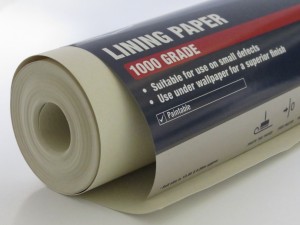Using lining paper
Using lining paper on walls, and ceilings, is a decorating technique carried out for two primary reasons. Firstly, lining paper may be used to provide a base onto which you then hang a decorative wallpaper, or, secondly it can be used to help even out imperfections on a wall or ceiling surface, before paint is applied. In this guide, I’ll explain the main properties, and types, of lining paper, and the points you need to consider when deciding on whether using lining paper is right for your situation.
Lining paper size and grades
Lining paper is normally a slightly off white colour and comes in a number of different grades ranging from 600, and then stepping up in 200s all the way to 2000 (you may find some lining papers outside of this range, but 600-2000 is the norm). These grades relate to the thickness of the paper with 600 being the thinnest, and 2000 being the thickest. Personally, I’ve always felt 600, and 800, too thin, unless you have perfect walls to begin with, and anything above 1200 starts becoming difficult to handle; therefore, I’ve normally tended to use 1000 as first choice, and 1200 if the walls have more than average imperfections.

1000 grade lining paper is always my first choice.
Lining paper width is normally slightly wider than standard wallpaper (which is generally 52cm), with 54cm and 56cm being the norms. Why this is the case? I really don’t know, but the commonly held perception is that it means that if you hang your lining paper vertically, then the seams will not coincide with any wallpaper you choose to hang over the top of it. This may well be the reason why, but it never makes sense to me, as the chances of you starting hanging your wallpaper in the same place as your lining paper is highly unlikely, and even if you did want to do that, then you’d just shift your first wallpaper length’s position slightly! Also, most lining is best done horizontally, so seams coinciding is never going to happen.
Suffice to say, don’t worry about the different widths, but if you can get extra long rolls (double, or quadruple the normal 10m length of standard rolls), so much the better, as you will have much less wastage, and you will also save some money.
Preparing wall surfaces
Just because a wall is being lined, it doesn’t mean that you can avoid filling, sanding and generally preparing the wall surfaces to get them into as smooth a condition as possible, prior to hanging the lining paper. Don’t be fooled into thinking that lining paper will cover up every imperfection, so always do a thorough preparation job. A thicker paper will help slightly, but generally if there’s lumps and bumps in the wall before you line, then they’ll still be there after you’ve lined.
Lining before wallpapering
The age old question of “should you line before wallpapering?”, is never completely straightforward to answer. In general, I always line before wallpapering as it tends to act as a guarantee that seams won’t split open, the finish will be more even, and the paper will last longer. That said, I’ve seen many a wallpaper hung directly onto a wall surface, with no problems whatsoever. Some sensible rules to go by are:-
- If the wallpaper manufacturer stipulates walls must be lined – then you definitely line.
- If the wallpaper recommends lining – then you definitely line.
- If the wallpaper manufacturer doesn’t mention lining – it’s up to you to take a risk, but if it was me, I’d definitely line!
Admittedly, I haven’t given you much room to manoeuvre here, but unless you’re going to hang a very cheap wallpaper – why take the risk? Also, I’ve mentioned manufacturer’s instructions above, and I can’t stress how important it is to read them thoroughly. For example, many manufacturers will insist you use the same type of paste for the lining paper, as you will use for the wallpaper (which is generally good practice anyway). Also, many of the new paste-the-wall wallpapers stipulate you must use paste-the-wall lining paper as your base, rather than a traditional paste-the-back lining paper.
Lining before painting
If you decide to line walls, or ceilings for that matter, before painting, you really do need to think why? For example, if I am advising a client on decorating a room, if the walls are in a poor condition, I have to decide whether the time it would take to prepare and line the walls is going to be more expensive, than simply getting the walls re-plastered. In the vast majority of cases, if I judge that filling, sanding and painting would not produce the finish required, then I normally opt for plastering as it will generally be the most cost effective option.
Now, in terms of DIY, hanging lining paper is much more possible than perfectly plastering a room, so you may choose lining, but it’s always worth balancing up the cost/benefits of the amount of work needed to get walls into a paintable condition, against getting a plasterer in for the day.
For more information on how to use lining paper, please check out my guide ‘Lining walls’.
